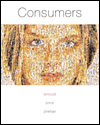 |  Consumers Eric Arnould,
University of Nebraska
George Zinkhan,
University of Georgia
Linda Price,
University of Nebraska
Economic and Social Structures
Internet Exercises- Visit two very different retail web sites (example; POLO and K-Mart)
think about different levels of socio-economics and its influences on consumer
behavior. How have the marketers of these two very different socio-economic
consumer bases developed their sites to appeal to their prospective customers?
Identify the most important differences and any interesting similarities. Which
of these sites has done a better job in your opinion of attracting and servicing
their targeted audience? Why?
- When fashion trends start in the lower class and spread upwards, this is
called status float. Identify a site and the particular trend(s) that
is a good example of having implemented status float. Explain how the WWW
has influenced the consumer behavior of this market.
- As a result of a stagnant growth in "mainstream" market segments,
relatively strong rates of demographic growth among ethnic communities, and
recognition of their purchasing power-15% of the U.S. total for example-marketing
consultants from the U.S. to Australia and South Africa extol the virtues
of multi-cultural marketing, or special targeting of ethnic minorities.
Identify such a multi-cultural site and explain how and what the site does
to enhance special targeting of ethnic minorities.
|
|




 2002 McGraw-Hill Higher Education
2002 McGraw-Hill Higher Education


 2002 McGraw-Hill Higher Education
2002 McGraw-Hill Higher Education